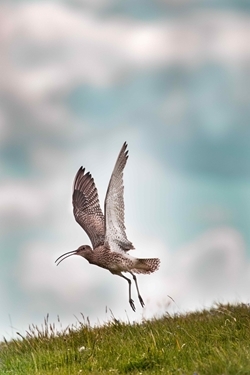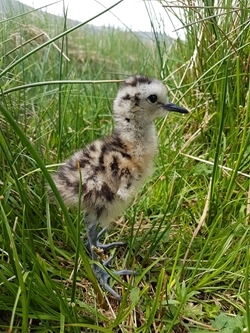Key points
- Monitoring curlew and other ground-nesting birds is essential for effective conservation efforts but previous methods have been time consuming and delay action.
- Researchers trained a new AI model called YOLOv10 by combining a pre-existing conservation AI database with nearly 39,000 images from across the UK.
- They then tested the system’s ability to monitor curlew and their chicks on 11 sites across Wales during the nesting season of 2024.
- By utilising 3G and 4G networks to send images to the AI technology, the camera system could efficiently process the images and detect curlew in real-time.
- This new system proved to be highly accurate, removing the data-processing burden on conservationists and allowing faster, more effective, conservation action.
Background
 Ground-nesting birds are an essential component of open grassland and wetland ecosystems. For example, they regulate insect populations and due to their delicate habitat requirements, ground-nesting birds serve as key indicators of wider environmental changes.
Ground-nesting birds are an essential component of open grassland and wetland ecosystems. For example, they regulate insect populations and due to their delicate habitat requirements, ground-nesting birds serve as key indicators of wider environmental changes.
Unfortunately, the open habitats they rely on are being encroached by agricultural intensification, urban development and other changes in land use. Furthermore, nesting on the ground makes them very vulnerable to predation by foxes, badgers and corvids which all eat their eggs and chicks. This means ground-nesting species such as lapwings, skylarks and curlews are struggling to maintain stable populations.
Monitoring these birds is crucial for identifying key areas of improvement in conservation efforts. Curlews are a major conservation concern in Wales, with current decline rates suggesting they could disappear from the region by 2033. Conservation efforts for vulnerable birds like curlews are often labour intensive and logistically challenging.
Nest monitoring usually involves physical observations or the use of camera traps. Camera traps are particularly useful for ground-nesting birds. They offer a non-invasive, long-term monitoring method for studying nesting behaviour, population trends and predator interactions. However, processing the vast number of images is time-consuming, delaying conservation action.
The use of AI technology is advancing rapidly, and in the field of ecological research this is no exception. However, current AI systems are designed for general wildlife monitoring rather than targeted conservation efforts for species like curlew. They only filter out blank images or provide broad classifications such as animals, humans and vehicles. Current systems still do not process the data in real time either, storing images on SD cards which have to be retrieved manually.
What they did
 Researchers from Liverpool John Moores University and the GWCT developed an AI-powered system using automated cameras and machine learning to remotely detect and classify curlews and their chicks. The goal was to improve conservation efforts by making species detection faster and more efficient. By automating image collection and classification, the system significantly improves the speed and accuracy of ecological assessments.
Researchers from Liverpool John Moores University and the GWCT developed an AI-powered system using automated cameras and machine learning to remotely detect and classify curlews and their chicks. The goal was to improve conservation efforts by making species detection faster and more efficient. By automating image collection and classification, the system significantly improves the speed and accuracy of ecological assessments.
Using a cutting-edge AI deep learning model called YOLOv10, the team trained it to recognise 26 different species, including curlew, foxes, deer and rabbits. They gathered nearly 39,000 images from conservation partners and private cameras across the UK. To make training faster and more efficient, they enhanced the AI’s accuracy by using an existing model with a large dataset (MS COCO) before fine-tuning it with the new UK wildlife images.
To help the AI handle real-world challenges, the team taught it to recognise animals under different conditions, such as changes in lighting, angles and sizes. This was done through data augmentation, a technique that adjusts images by changing colours, brightness and flipping them to create variety.
To evaluate how effective the model was in monitoring curlews, researchers tested it across 11 sites in Wales between 20 May and 30 June 2024. The AI system analysed 1,072 images using 3G/4G-enabled cameras to capture and instantly analyse images, allowing real-time detection and monitoring of curlew populations.
What they found
The results of the trial were promising, with the model demonstrating high accuracy in curlew detection. It performed consistently across challenging environments, including long grass and complex backgrounds. A key advantage was its ability to filter out blank images triggered by moving vegetation; in practice this will significantly reduce conservationists’ workload.
The tests also proved the model could reliably identify curlew chicks, despite their natural camouflage. The system successfully removed the data-handling burden and processing delays, allowing conservationists and researchers to respond quickly and protect breeding curlew.
The model performed well in detecting curlews, correctly identifying them over 90% of the time and never falsely detecting them when they were not present. Its overall accuracy was high, balancing correct detections with minimal errors.
There were a few issues noted during this practical application of the technology. The model did get confused between adult curlews and pheasants in some instances or occasionally sheep. This likely resulted from some camera trap installations not following guidelines, leading to skewed colouring, poor lighting or only partial bird images.
Environmental factors like rain or condensation on the camera lens limited the system’s ability to discern the features of curlews. Camera placement was also critical for detecting smaller objects such as curlew chicks as well as ensuring the best trigger settings, quality images and overcoming the challenges of cluttered environments.
What does this mean?
 This cutting-edge sensor and AI technology supports large-scale biodiversity surveys by overcoming the challenges of remote areas. It can help researchers track curlew populations over extended periods and identify key intervention points. Reducing reliance on manual processing means this new technology can provide real-time alerts on critical events such as nesting or chick presence, enabling faster conservation responses.
This cutting-edge sensor and AI technology supports large-scale biodiversity surveys by overcoming the challenges of remote areas. It can help researchers track curlew populations over extended periods and identify key intervention points. Reducing reliance on manual processing means this new technology can provide real-time alerts on critical events such as nesting or chick presence, enabling faster conservation responses.
This new AI model has several key applications that will enhance wildlife monitoring and conservation efforts, particularly for curlew populations. Hosting the model on the Conservation AI platform further enhanced its scalability. This allows researchers to apply the model more broadly to monitor other species or to expand curlew conservation efforts. This flexibility makes the technology a reliable tool for a range of biodiversity monitoring.
Additionally, the system creates opportunities for community involvement, allowing citizen scientists to contribute by setting up cameras in local environments such as gardens, parks or workplaces. This approach not only increases the amount of data collected but also encourages public engagement in conservation, raising awareness about the importance of protecting wildlife.
A significant benefit of this AI-driven approach is its ability to continuously improve over time. As more data is gathered, both from researchers and citizen scientists, the model becomes more accurate in identifying different species. This ongoing refinement ensures better classification and reduces errors in detection. However, to maintain high-quality data, future work will focus on refining methods for camera placement and addressing misclassification issues, such as confusing curlews with common pheasants. Enhancements in data quality, improved training techniques, and fine-tuning of model parameters will further strengthen its performance.
Ultimately, this system provides a strong foundation for long-term conservation efforts. By making the AI model publicly available, the research empowers scientists, conservationists and volunteers to contribute to curlew population recovery and broader wildlife monitoring initiatives.
The findings from this study also lay the groundwork for a long-term curlew nesting season survey in 2025, allowing researchers to evaluate the effectiveness of this approach over time and measure its impact on curlew conservation.
Read the original paper
Chalmers, C, Fergus, P, Wich, SA, Longmore, SN, Walsh, ND, Oliver, L, Warrington, J, Quinlan, J and Appleby, K (2025) AI-Driven Real-Time Monitoring of Ground-Nesting Birds: A Case Study on Curlew Detection Using YOLOv10. Remote Sensing, 17 (5). pp. 1-21.